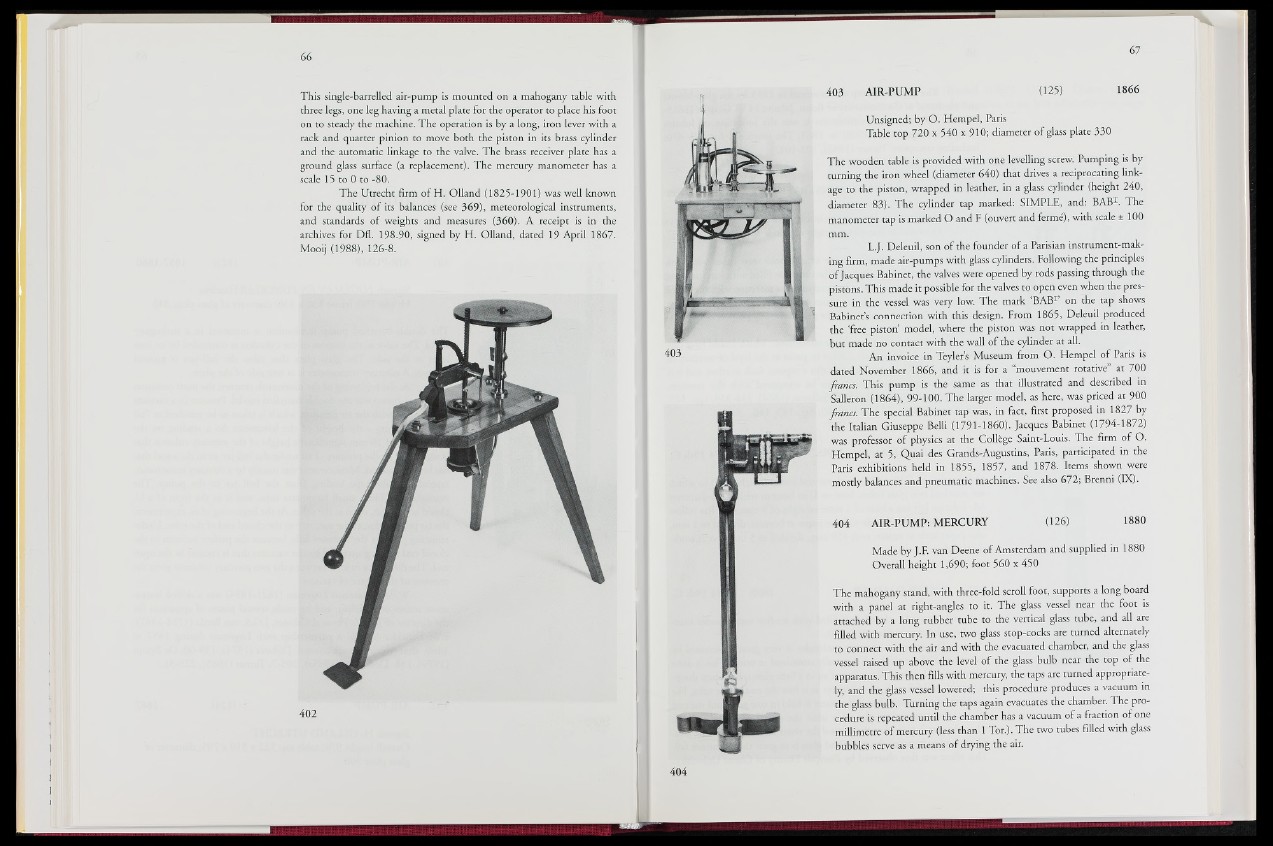
This single-barrelled air-pump is mounted on a mahogany table with
three legs, one leg having a metal plate for the operator to place his foot
on to steady the machine. The operation is by a long, iron lever with a
rack and quarter pinion to move both the piston in its brass cylinder
and the automatic linkage to the valve. The brass receiver plate has a
ground glass surface (a replacement). The mercury manometer has a
scale 15 to 0 to -80.
The Utrecht firm of H. Olland (1825-1901) was well known
for the quality of its balances (see 369), meteorological instruments,
and standards of weights and measures (360). A receipt is in the
archives for Dft. 198.90, signed by H. Olland, dated 19 Aprifid 867.
Mooij (1988), 126-8.
¡St-
403 AIR-PUMP
Unsigned; by O. Hempel, Paris
Table top 720 x 540 x 910; diameter of glass plate 330
The wooden table is provided with one levelling screw. Pumping is by
turning the iron wheel (diameter 640) that drives a reciprocating linkage
to the piston, wrapped in leather, in a glass cylinder (height 240,
diameter 83). The cylinder tap marked: SIMPLE, and: BAB1. The
manometer tap is marked O and F (ouvert and fermd), with scale ± 100
mm.
L.J. Deleuil, son of the founder of a Parisian instrument-making
firm, made air-pumps with glass cylinders. Following the principles
of Jacques Babinet, the valves were opened by rods passing through the
pistons. This made it possible for the valves to open even when the pressure
in the vessel was very low. The mark ‘BAB1’ on the tap shows
Babinet’s connection with this design. From 1865, D slj5 l produced
the ‘free piston model, where the piston was not wrapped in leather,
but made no contact with the wall of the cylinder at all.
An invoice-in Teyler’s Museum from O. Hempel of Paris is
dated November 1866, and it is for a “mouvement rotative” at 700
francs. This pump is" the same as that illustrated and described in
Salleron (1864), 99-100. The larger model, as here, was priced at 900
francs. The special Babinef'tap was, ! j fact, first proposed tft 1827 by
the Italian Giuseppe Belli (1791-1860). Jacques Babinet (1794-1872)
was professor of physics at the College Saint-Louis. The firm of O.
Hempel, at 5, Quai des Grands-Augustins, Paris, participated in the
.laris exhibitions held in 1855,® 8 5 |, and 1878. Items shown were
mSStly balancjSjand pneumatic machines. See also 672; Brenni (IX).
404 AIR-PUMP: MERCURY
Made by J.F. van Deene of Amsterdam and supplied in 1880
Overall height 1,690; foot 560 x 450
The mahogany stand, with three-fold scroll foot, supports a long board
with a panel at right-angles to it. The glass vessel near the foot is
attached by a long rubber tube to the vertical glass tube, and all are
filled with mercury. In use, two glass stop-cocks are turned alternately
to cofflf ect with the air and with the evacuated chamber, and the glass
vessel raised up above the level of the glass bulb near the top of the
apparatasi This* then fills with mercury, the taps are turned appropriately,
and Éfe glass vess'èl lowered; this procedure prod^fpja vacuum in
the glass b'hlb. Turning the taps again evacuates the chamber. The procedure
is repeated until the chamber has a vacuum of a fraction of one
-millimetre of mercury (less than 1 Tor.). The two tubes filled with glass
bubbles serve as a means of drying the air.
MSS3@BSWE8Bì&MbÌM